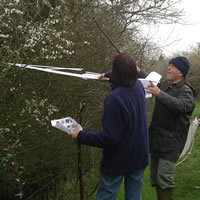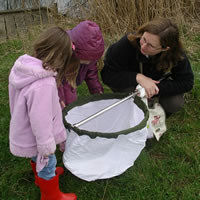Ladybirds occur in many habitats throughout the UK from gardens to the wider countryside. The abundance and bright colours of some of the more common species of ladybird make them very easy to spot.
However, not all species are seen so easily and more rigorous sampling techniques are essential to thoroughly assess the different ladybirds found in a specific area.

Searching by Eye
A ladybird hunt can begin by simply turning over leaves, sifting through leaf litter and looking in crevices in bark or buildings. All observations should be recorded preferably on-line.
Beating
Beating trays can be purchased from suppliers of ecological or entomological equipment but alternatively an upturned umbrella can serve the same purpose.
Sweeping
A sweep net can be used for searching meadows, grasses, heathland or other low growing vegetation types. A sweep net is comprised

of a white fabric bag held open by a stout ring attached to a handle. The sweep net is best used by walking slowly and sweeping from side to side. Considerable coverage of an area can be made quite quickly using this method.
Sweep nets can be purchased from suppliers of ecological or entomological equipment but they can also be made cheaply. A metal circle of 40 cm diameter should be constructed (using three pieces of thick wire bent into a circle with the ends twisted together) and the twisted ends of the circle should be pushed into the end of dowelling (1 m long and 2.5 cm diameter). The bag (45 to 60 cm deep) can be made using strong white fabric with a hem of sufficient width to thread the metal hoop through.
Other useful equipment and resources
- Please record your ladybird sightings in iRecord or using the iRecord Ladybirds app
- Containers for collecting ladybirds (any solid container with a secure lid can be used but plastic containers produce less condensation, which can kill ladybirds, than glass containers. Remember to keep containers with ladybirds in out of direct sunlight because this will rapidly kill ladybirds)
- Soft paintbrush (particularly useful for handling the more fragile larval stages)
- Hand lens (at least x 10)
- Field guide: Roy et al. (2013) Ladybirds. Pelagic Publishing
- FSC fold-out identification charts: adults and larvae
- Ladybird atlas: Ladybirds (Coccinellidae) of Britain and Ireland
